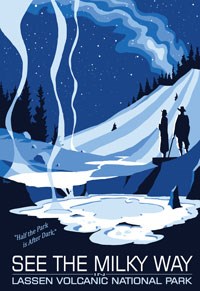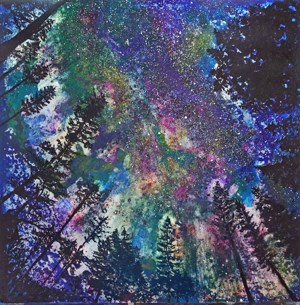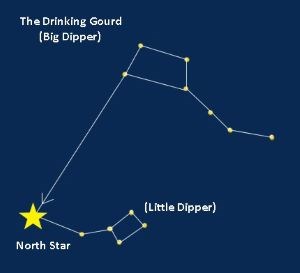
Alison Taggart-Barone 
Half the park is after dark! From animals to plants and water to volcanoes, Lassen Volcanic National Park protects many different natural phenomena. One of the most spectacular is frequently overlooked -- our incredible, dark, night sky. Lassen Volcanic is one of the best places to learn about and enjoy the splendor of the night sky. Far from the light pollution of civilization, Lassen is one of the last sanctuaries of natural darkness. Whether you have yet to experience the grandeur of the Milky Way or you are a dedicated amateur astronomer, Lassen's dark skies offer unparalleled view of the celestial wonders. Experience Lassen after dark:
Stargaze in the ParkTips for Getting Started:
Where to GoYou can enjoy the dark night sky in Lassen Volcanic anywhere you can see the sky. Many campsites in the park are forested, so you may want to head to a lakeshore, a meadow, or even a parking area to get a wider view of the sky. There are very few lights in the park at night, however getting away from buildings, headlights, or even camp lights can also improve your view of the sky. Be sure to avoid areas that are wet or with uneven terrain that may pose a tripping hazard.
*Please note that overnight camping is only allowed in campgrounds and is not permitted in pullouts or parking areas (except Kohm Yah-mah-nee Visitor Center with camping fee). Take a Full Moon Hike Kids age 5 and older can complete the Junior Ranger Night Explorer booklet in the park and earn a Junior Ranger Night Explorer patch. Here's how:
Can't complete Junior Ranger - Night Explorer while at the park? That's okay! Download the booklet to complete it virtually. Virtual learneers will receive a digital high-five. An award patch cannot be mailed. Or, print the activites booklet before your arrival to Lassen and bring it to a visitor center for a patch in person. Stargaze Where You LiveLook up at Home
In Your Town
Learn More About the Night Sky in the Lassen AreaShasta Astronomy Club is composed of amateur astronomers and night sky enthusiasts in the Redding and the North State community. The club's emphasis is observing with telescopes and binoculars, and offering public outreach. SAC offers special events at nearby Whiskeytown National Recreation Area and collaborates with Lassen National Park for trainings and special events. The Astronomical Society of Nevada is a non-profit service organization introducing the pubic to astronomy. The ASN contributes to Lassen's night sky programming and special events, offers public telescope viewing in the Reno area, conducts public star parties at Washoe County schools and parks, and more. Learn more about ASN programs and activities. 
Stories in the StarsWhen we look up at a dark night sky, we are essentially seeing the same sky that humans have looked upon for thousands of years. The same dark and starry sky has evoked countless myths, art, literature and music from cultures around the world. 
North Star to FreedomAs slave lore tells it, the North Star played a key role in helping slaves to find their way—a beacon to true north and freedom. Escaping slaves could find it by locating the Big Dipper, a well-recognized asterism most visible in the night sky in late winter and spring. As the name implies, its shape resembles a dipping ladle, or drinking gourd. From the gourd’s outline, the North Star could be found by extending a straight line five times the distance from the outermost star of the bowl. Night Skies Activities PartnersMany Dark Sky viewing events are made possible by the support of numerous partners who contribute their time, expertise, and passion for our dark night sky. Partners volunteer their time each summer, to share their knowledge with our park visitors. The Astronomical Society of NevadaThe Astronomical Society of Nevada (ASN) is a non-profit service organization introducing the pubic to astronomy. Several members of the ASN participate by providing access to telescopes pointed at planets, star clusters, and distant galaxies, as well as daytime solar scope viewing.The ASN also offers public telescope viewing in the Reno area, conduct public star parties at Washoe County schools and parks, and more. Learn more about ASN programs and activities. International Dark Sky AssociationThe International Dark Sky Assocationa (IDA) works to protect the night skies for present and future generations. The IDA works to preserve and protect dark sites through responsible lighting policies and public education and is the organization responsible for designating places as an International Dark Sky Park, Reserve, Sanctuary, or Community. Lassen Volcanic National Park is currently working through the process of obtaining its Dark Sky Park designation. The IDA staffs a tent and provides information about how we can preserve dark night skies. NASA Ames Research CenterNASA's Ames Research Center, one of ten NASA field centers, is located in the heart of California's Silicon Valley. There is a close connection between the park and Ames Research Center. Astrobiology research by scientists from the Ames Research Center and astrobiology student interns contribute to an ever-growing collection of documentation on the diverse thermal features and microbial populations in the park. Research Scientists including Niki Parenteau, Dave Des Marais, and several others from Ames Research Center participate by giving presentations about discoveries on Mars and staffing a tent with astrobiology specimens and demonstrations. National Radio Astronomy ObservatoryFounded in 1956, the National Radio Astronomy Observatory (NRAO) provides state-of-the-art radio telescope facilities for use by the international scientific community. NRAO telescopes are open to all astronomers regardless of institutional or national affiliation. Observing time on NRAO telescopes is available on a competitive basis to qualified scientists after evaluation of research proposals on the basis of scientific merit, the capability of the instruments to do the work, and the availability of the telescope during the requested time. NRAO also provides both formal and informal programs in education and public outreach for teachers, students, the general public, and the media. Placerville Community ObservatoryPlacerville Community Observatory is located in Placerville, CA and hosts free public viewings. The observatory is open summer months and winter months when the humidity is not too high and it is not cloudy. Sacramento Valley Astronomical SocietyThe Sacramento Valley Astronomical Society is a nonprofit educational society focused on fostering interest in astronomy. The SVAS serves the community of Nothern California through programs such as telescope workshops, loaner telescopes program, and member star parties. Schreder PlanetariumSchreder Planetarium is located in Redding, CA and serves students and citizens of northern California. You can enjoy a variety of programs in the domed theater, from scientific documentaries to science fiction stories. Shasta Astronomy ClubShasta Astronomy Club (SAC) is composed of amateur astronomers and night sky enthusiasts in the Redding and the North State community. The club's emphasis is observing with telescopes and binoculars, and offering public outreach. SAC offers special events at nearby Whiskeytown National Recreation Area and participates in Lassen's dark sky events. SOFIA Science CenterThe Stratospheric Observatory for Infrared Astronomy (SOFIA) is an extensively modified Boeing 747SP aircraft carrying a reflecting telescope with an effective diameter of 2.5 meters (100 inches). SOFIA studies many different kinds of astronomical objects and phenomena, including the lifecycle of stars, the formation of new solar systems, black holes at the center of galaxies, and complex molecules in space. The observatory's instruments — cameras, spectrometers, and photometers — operate in the near-, mid- and far-infrared wavelengths, enabling scientists onboard to study the solar system and beyond while flying at 38,000- 45,000 feet. The SOFIA Program Office is at NASA Ames Research Center in Moffett Field, CA, which helps manage SOFIA's science and mission operations. Learn more on the SOFIA YouTube Channel. Space Telescope Science InstituteThe Space Telescope Science Institute is located in Baltimore, Maryland, operated by the Association of Universities for Research in Astronomy. They help humanity explore the universe with advanced space telescopes and ever-growing data archives. Established in 1981, they helped guide the most famous observatory in history, the Hubble Space Telescope. Since its launch in 1990, they have performed the science operations for Hubble. Virtual space exploration and science-learning sites - James Webb Space Telescope, Hubble Space Telescope, August 2020 Night Sky Viewing, and NASA's Universe of Learning. Independent PartnersWe'd like to acknowledge and thank our independent partners and volunteers including Dave Schlom, Dave Samuels, Dave White, Adam Back, Bruce Agee, Bob Shoulders, Chad Moore, David McMullen, Norm Nasise, Mike Ryan, Kevin McLin, Valerie Kircher, Shreeni Manievannan, Anna Roedocker-Mann, Vic Maris, and many others who have contributed their time over the years.We truly value and appreciate any time and contributions that you've given to us each and every year, and we look forward to working with you for many more years in the future! |
Last updated: September 19, 2024
